For the first part of this adventure, click here.
You know what I did first, don’t you? You know you do, you just don’t want to hear me say it.
I swatched.
Confession time: I love swatching.
If that makes you bristle, let me reassure you that I understand. I wasn’t always like this. I used to hate swatching. Swatching was vile. Swatching was the pile of green beans my mother used to force-feed me before I was allowed to have a cookie. I hated green beans.*

Why did I change? Experience. People say swatches lie, and swatches do. But the most deceitful swatch still tells you more that no swatch at all.
Swatching isn’t just about checking your gauge to make sure you end up with something of the correct size. It’s also about testing the fabric. Does it look good? Does it have the right amount of drape? Frankly, it doesn’t matter if you “get” gauge but the yarn you’ve chosen to get it gives you a fabric stiff as cardboard and you’re looking to make a shawl.
With shadow knitting, my favorite way to swatch is just to pick one color or the other and start knitting a piece of garter stitch. Here’s the kind of garter stitch I look for:
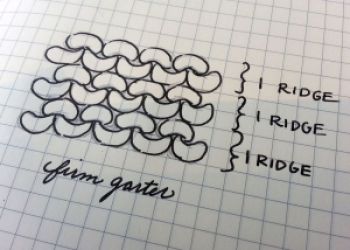
See how nice and snug those ridges are? That’s good. Here’s what I avoid:
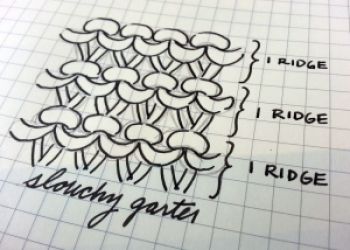
If you get snug garter stitch, the gauge of your shadow fabric will generally give you a bold, legible hidden pattern.
This was also a good test flight for the Schoppel Gradient. As I mentioned in the last installment, I was concerned that the slightly irregular nature of the yarn might render it unsuitable for shadow knitting. But when I saw these nice, plump garter ridges

I knew I was good to go.
That’s what a swatch is supposed to do for you, you know–let you set forth without anxiety. Or at least with less anxiety.
What pattern to knit, though? I wanted, on this test flight, to try out the shifting colors and see how they’d play against one another. That meant keeping it simple. A square would have grown monotonous very quickly, so I charted up a circle.

As I’d hoped, what grew was a series of bold explosions on a moody background. The nature of shadow knitting is to stretch out motifs, so they were more oblong than circular. I liked that.

I also liked the way the simultaneous changes in the background and foreground led to the unexpected.
All the while, one thought kept nagging me. These looked like something I’d seen. What was it? Paints in a paintbox? Not quite. Candies on a tray? Definitely not.
I was talking with a knitter friend when it hit me.
“They look like the sun rising through clouds. In the morning, when they’re storm clouds full of city pollution, and I’m at the airport, and it’s really early, and my eyes are kind of bleary, and I have hours of horrible flying before I’ll get any kind of rest.”
“That’s cheery,” he said.
“Angry sunrises,” I said. “Eleven angry sunrises.”
“Some people are inspired by pretty flowers,” he said.
“That’s what I’m going to call this,” I said. “Eleven Angry Sunrises.”
“You can’t call a knitting pattern ‘Eleven Angry Sunrises.’”
“Why not?”
“Because it sounds angry. Knitting is supposed to make you think happy thoughts.”
“Well, I’m not calling it Eleven Happy Sunrises.”
“Why not?”
“Because it sounds like the name of a cult.”
“And what is knitting?”
I have to admit he had a point.
Your Own Adventure: Recipe for Eleven Happy (or Angry) Sunrises
Procure two skeins of Schoppel Gradient in different colorways. The more difference between your colorways, the bolder your surprises will be.
You will also need two stitch markers, and the shadow circle chart above. And of course, scissors and a tapestry needle. (Do I really have to tell you that? Patterns always tell you that, but do they really have to?)
As described above, knit a good-sized garter stitch swatch (about four inches by four inches will do it) to make sure you have a firm but not tight fabric. If the fabric could stand up in the corner by itself, it’s too firm. If it looks like fishnet, it’s too loose.
Don’t bind off the swatch; rip it out so you can use the yarn.
With your first color, cast on 27 stitches.
You’re going to put garter stitch borders around the sunrises just for pretty. So knit two rows with Color One, then join Color Two and knit two rows with that. From this point on, you will always alternate two rows of Color One, then two rows of Color Two.
Enough border. Time for pattern.
With Color One, knit three stitches. That’s your right-hand garter stitch border. Place a stitch marker. Knit the first row of the chart. You’ll have three stitches left; place a marker, then knit them. Those are your left-hand border.
Now, follow the chart when you’re inside the markers. Outside the markers, knit all stitches. Don’t cut the yarns at the end of each stripe, just carry them up the right-hand selvedge as you work.
When you have had quite enough, knit two more garter stripes–one in each color–and bind off using the color of the final stripe.
Block, if you like. Weave in ends. Admire.
Our next adventure begins in two weeks…click here.
*I still hate green beans.
Tools and Materials Appearing in This Issue

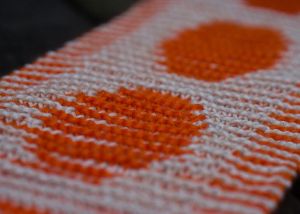
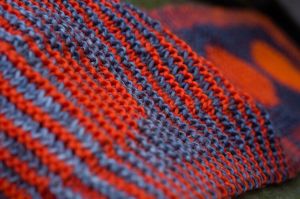
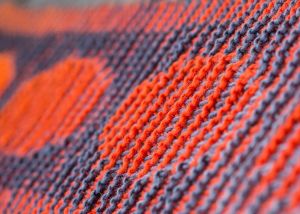

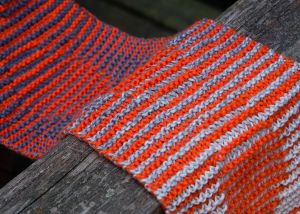
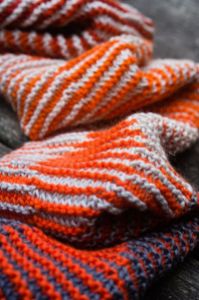


One thought on “Fridays with Franklin: Adventure in the Shadows, Part Two”